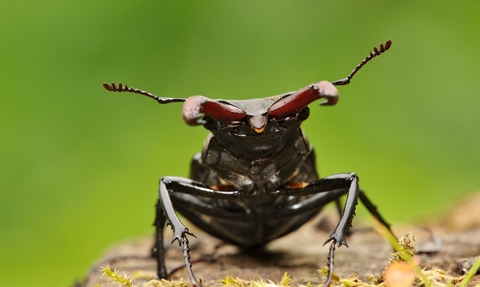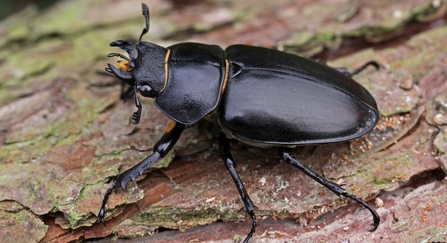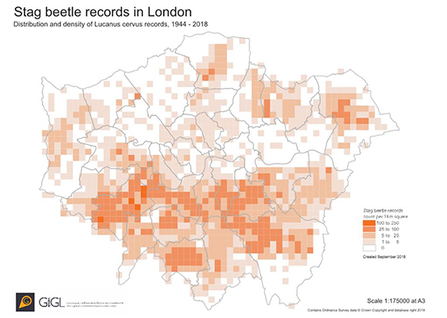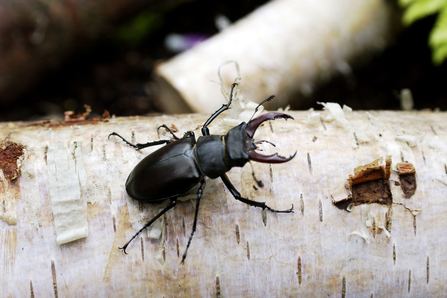
Stag Beetle credit Terry Whittaker/2020VISION
Help save London’s stag beetles
The stag beetle is Britain’s largest land beetle, almost 8cm in length, and is easily recognised by the male’s distinctive antler-shaped jaws. Although the male beetles look fearsome they are harmless to us. They use their massive jaws to wrestle with other males when looking for a mate.
Despite stag beetles being in steep decline across Europe, London remains a hotspot. We are asking you to report your sightings in London to help researchers map their whereabouts and numbers.
Stag beetles have been recorded in most London boroughs, but are much more commonly seen in south and west London, from Bexley, Lewisham and Southwark to Wimbledon, Richmond and Uxbridge.
Three sites – Epping Forest, Richmond Park, and Wimbledon & Putney Commons – are designated European Special Areas for Conservation partly for stag beetles. Researchers still don’t know why there have been relatively fewer sightings across north and east London.
May is usually the start of the ‘stag beetle season’, which lasts until late July. The males fly clumsily with a faint clattering whirr, and are most likely to be seen on sultry summer evenings an hour or two before dusk.
Please report any sightings of stag beetles, or of the related lesser stag beetle.

Lesser stag beetle credit Margaret Holland
The below map only shows where stag beetles have been recorded in London, and may not present an accurate representation of where they live, because not all sightings are recorded. Our aim is to create a more accurate map by encouraging more people to record their stag beetle sightings.

How you can help London's stag beetles
As well as reporting your sightings of stag beetles, there are lots of things you can do to help them, especially if you have access to a garden.
- Download our stag beetle advice note for guidance on how to build a stag beetle log pile;
- For some great wildlife gardening tips and advice, take a look at our wildlife gardening page.
Share your stag beetle pictures and videos
We would love to see your photographs or videos of stag beetles. If you are lucky enough to get some pictures, please contact us at marketing@wildlondon.org.uk
You can share on social media using #StagBeetleSummer and @iGiGL
We would like to be able to share any pictures or video you send us, so please let us know who to credit. If you would prefer that we do not share your pictures or video, just let us know.
How to spot a stag beetle
- Stag beetles tend to be between 5cm and 8cm long;
- Male stag beetles have very large, antler-shaped jaws;
- Males are often seen flying on sultry summer evenings an hour or two before dusk;
- Female stag beetles lack the males' antlers and are much more likely to be spotted on the ground. Their jaws are smaller than the males', but are more powerful;
- Adult stag beetles emerge from the soil beneath logs or tree stumps from mid-May til late July;
- You are most likely to find a stag beetle near or on dead wood. Stag beetles spend most of their lives as larvae (grubs) within dead wood such as tree stumps and logs, where they spend 4-7 years slowly growing in size.

More stag beetle facts
- Stag beetles may be inadvertently destroyed in the mistaken belief they are pests, and in urban areas traffic, feet, cats and other predators can also have a negative impact;
- The decline in stag beetle numbers is attributed to the tidying up of parks, gardens and greenspaces and the removal of tree stumps and deadwood. Without deadwood the beetles have nowhere for their larvae to grow. The beetles play an important role in the cycle of decay; eating and breaking down deadwood so that it nourishes the soil;
- In 2016, Seb Dance MEP became a champion of the stag beetle as part of the Species Champion initiative, promoting the conservation of species of European importance, in partnership with London Wildlife Trust, RSPB, and the People’s Trust for Endangered Species (PTES).
If you have seen a stag beetle outside London, you can report your sighting via the PTES website.
